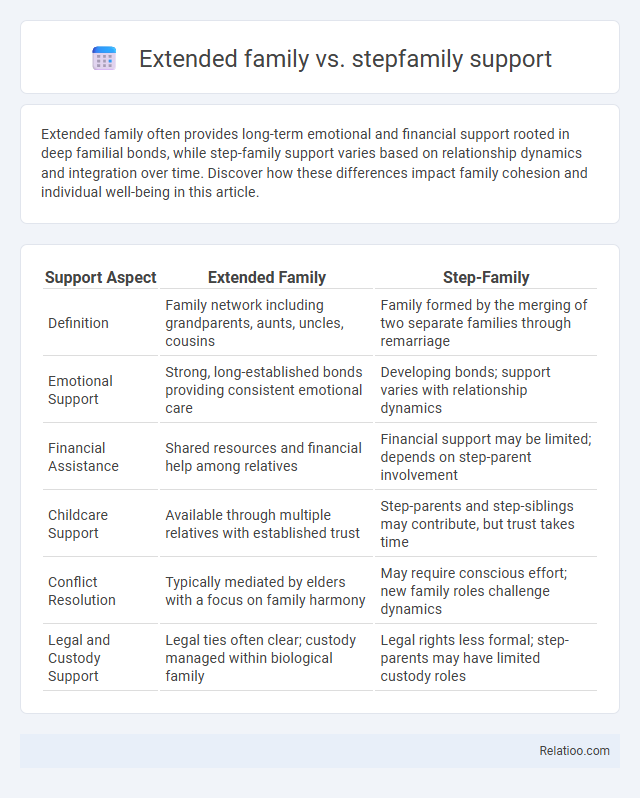Extended family often provides long-term emotional and financial support rooted in deep familial bonds, while step-family support varies based on relationship dynamics and integration over time. Discover how these differences impact family cohesion and individual well-being in this article.
Table of Comparison
| Support Aspect | Extended Family | Step-Family |
|---|---|---|
| Definition | Family network including grandparents, aunts, uncles, cousins | Family formed by the merging of two separate families through remarriage |
| Emotional Support | Strong, long-established bonds providing consistent emotional care | Developing bonds; support varies with relationship dynamics |
| Financial Assistance | Shared resources and financial help among relatives | Financial support may be limited; depends on step-parent involvement |
| Childcare Support | Available through multiple relatives with established trust | Step-parents and step-siblings may contribute, but trust takes time |
| Conflict Resolution | Typically mediated by elders with a focus on family harmony | May require conscious effort; new family roles challenge dynamics |
| Legal and Custody Support | Legal ties often clear; custody managed within biological family | Legal rights less formal; step-parents may have limited custody roles |
Understanding Extended Families
Extended families consist of multiple generations living together or maintaining close contact, providing emotional, financial, and childcare support that strengthens resilience and social stability. Step-family support involves relationships formed through remarriage, often requiring adaptation to new roles and boundaries to foster effective communication and trust. Support networks extend beyond family ties to include friends, community groups, and professionals, offering diverse resources that complement family-based assistance.
Defining Step-Families
Step-families are formed when one or both partners bring children from previous relationships, creating a blended family unit that requires navigating unique emotional and legal dynamics. Your support network in step-families often includes not only biological relatives from the extended family but also non-biological connections that provide crucial emotional and practical assistance. Understanding the distinctions between extended family support, which typically involves blood relatives, and step-family support helps clarify the diverse sources of help available in complex family structures.
Emotional Support: Extended vs Step-Families
Extended families often provide deep-rooted emotional support due to long-shared histories and strong kinship bonds, fostering trust and reliability in times of stress. Step-families may face challenges in establishing similar levels of emotional support initially, as relationships need time to build mutual understanding and acceptance. Support networks that include both extended and step-family members can enhance emotional resilience by combining diverse connections and resources.
Financial Assistance in Different Family Structures
Extended family often provides substantial financial assistance through pooled resources and shared responsibilities, creating a safety net for members in need. Step-family support varies widely but can offer unique financial help depending on the strength of relationships and legal obligations within blended households. Your financial stability benefits most when a diverse support network, including extended and step-family, collaborates to share resources and provide economic security.
Childcare Roles and Responsibilities
Extended family members, such as grandparents, aunts, and uncles, often provide consistent childcare support by sharing caregiving responsibilities and offering emotional stability. Step-family support involves blending roles where stepparents and stepsiblings contribute to daily childcare tasks, fostering trust and cooperation within restructured family dynamics. Support networks, including friends, neighbors, and community services, supplement childcare by offering flexible assistance, resources, and social engagement to enhance the child's development and well-being.
Conflict Resolution Dynamics
Extended family support often involves deeply rooted relationships shaped by shared history and cultural norms, which can either facilitate or complicate conflict resolution due to longstanding roles and expectations. Step-family support dynamics require careful negotiation of loyalty and boundaries, as new family members integrate and conflicts may arise from unclear roles or competing attachments. Support networks extend beyond familial ties, offering diverse perspectives and resources that can mediate conflicts more objectively and provide alternative problem-solving approaches.
Cultural Influences on Family Support
Extended family support often reflects cultural traditions valuing multigenerational caregiving and resource sharing, enhancing resilience in collectivist societies. Step-family support varies widely across cultures, influenced by norms regarding family integration and roles, which can affect emotional bonds and practical assistance. Support networks incorporate both extended and step-family ties, with cultural context shaping the extent and nature of reliance on these relationships for social, financial, and childcare support.
Communication Patterns in Family Types
Communication patterns in extended families often involve multilayered interactions among diverse relatives, fostering a rich exchange of support and traditions. Step-family communication emphasizes establishing trust and clear boundaries to navigate complex relationships and build cohesion. Your support network benefits from tailoring communication strategies to the unique dynamics of each family type, enhancing emotional connection and problem-solving efficiency.
Challenges Unique to Step-Families
Step-families often face unique challenges such as blending different family cultures, managing loyalty conflicts between biological and stepparents, and establishing clear roles within the household. Unlike extended families, where support is typically based on longstanding relationships and shared history, step-families must navigate complex emotional dynamics and build trust from scratch. Your support network should include open communication strategies and professional guidance to address these specific challenges effectively.
Strengthening Family Bonds Across Structures
Extended families offer a broad support network through multigenerational connections, enhancing resilience and shared resources. Step-family support plays a crucial role in blending different family units, fostering trust and communication to create cohesive bonds. Support networks integrate extended and step-family relationships, providing diverse emotional and practical assistance that strengthens overall family unity.

Infographic: Extended family vs Step-family support
 relatioo.com
relatioo.com